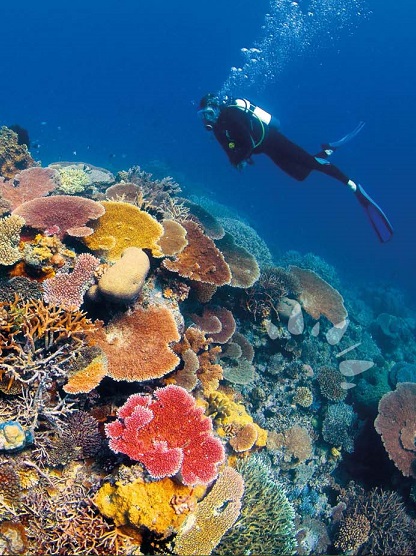Good results in Reef review
 The latest results from a comprehensive monitoring program on the Great Barrier Reef show signs of initial recovery of hard coral cover in the Marine Park.
The latest results from a comprehensive monitoring program on the Great Barrier Reef show signs of initial recovery of hard coral cover in the Marine Park.
Marine scientists recorded small increases in coral cover on the Great Barrier Reef according to new underwater survey results.
The Australian Institute of Marine Science’s (AIMS) Annual Summary Report on Coral Reef Condition for 2019/20 is drawn from surveys undertaken between September 2019 and June 2020, with most of the reefs surveyed before last Summer’s mass coral bleaching event.
The full effects of this event on coral cover will not be known for some months and may set back the Reef’s recovery.
Coral cover is a widely used measure to describe the proportion of the reef surface covered in live hard coral.
The report found that while there was considerable variation in coral cover between the 86 reefs surveyed, more than two thirds had slightly increased coral cover.
In the Central region between Hinchinbrook Island and Mackay, hard coral cover increased on average from 12 per cent in 2019 to 14 per cent in 2020.
Coral cover in the Northern Great Barrier Reef was stable, while it marginally increased in the Southern region.
These slight increases indicate recovery had begun after the Reef had been subjected to multiple disturbances from bleaching, cyclones and coral-eating crown-of-thorns starfish outbreaks.
This year, the Southern region had the highest cover of all three regions at 24 per cent, and historically has been the most dynamic, with strong recovery from 2011 (9 per cent) to 2017 (32 per cent).
This recovery was reversed from 2017 to 2020 due to crown-of-thorns starfish outbreaks in the Swains sector. Coral cover is currently just over half of what it was in 1988 (at 40 per cent this is the highest year recorded by AIMS).
“This monitoring program has been conducted continuously for 35 years. Our surveys along the length and breadth of the Great Barrier Reef tell us that the reef is resilient, but this resilience has limits,” says Dr Mike Emslie, leader of AIMS’ Long Term Monitoring Program.
“The slight increases in coral cover across much of the Great Barrier Reef this past year are encouraging but the full effect of the mass bleaching on coral mortality will not be known for several months.
“The Reef is taking repeated hits from coral bleaching, cyclones and crown-of-thorns outbreaks. While we have seen the Great Barrier Reef’s ability to begin recovery from these pressures, the frequency and intensity of disturbances means less time for full recovery to take place.
“The coral trout in the protected Green Zones of the Reef are bigger and there’s a lot more of them than in reefs open to fishing.
“As numbers of coral trout in protected areas increase and they grow larger in size, they produce more offspring. Some coral trout larvae are transported from Green Zones and re-seed populations in Blue Zones, which means more fish available for anglers.
“The new result confirms that the science behind the Marine Park’s rezoning continues to benefit Queenslanders.”








 Print
Print